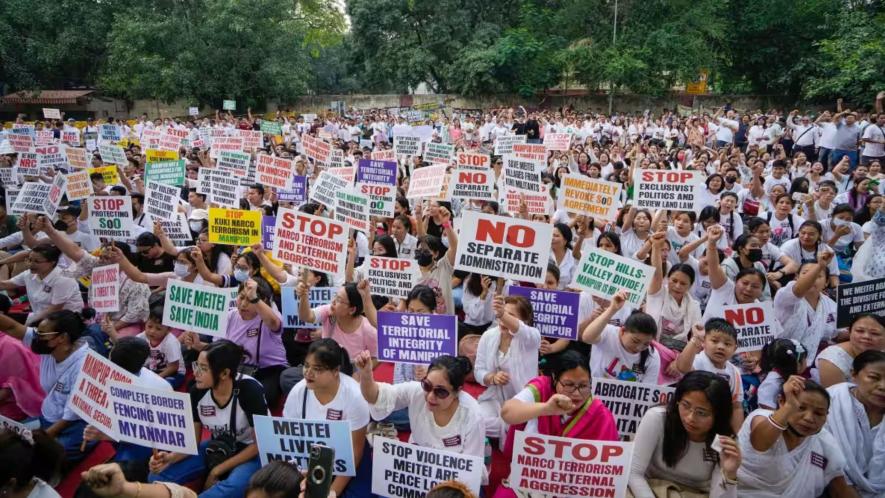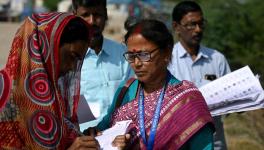What is Youth of Manipur, Outfit Demanding Peace in Conflict-Torn State

People from the Meitei community raise slogans during their protest at Jantar Mantar in New Delhi, Sunday, June 4, 2023. Image Courtesy: PTI
In the first week of this month, around 35 Manipuri MLAs and ministers returned empty-handed from Delhi to Imphal. They had held more than three rounds of discussions with a newly formed Manipuri youth collective between September 13 and 30 just as the conflict in the northeastern state entered its fifth month. But a week later, the negligible outcome of the discussions has left all sides wanting much more.
When contacted, the MLAs and the members of the new collective, Youth of Manipur (YoM), comprising Meitei youngsters aged 18-35 from Imphal, expressed sorrow and anger over the failure to negotiate a change in Manipur’s situation.
Earlier, 100 Manipuri youngsters had met the chief minister (CM) at his Imphal residence. “The Chief Minister’s Office suggested that 23 of us go to Delhi and meet the MLAs there and come up with a solution,” says a YoM member.
“The elected Meitei leaders had been in Delhi before. We were waiting to hear about their progress,” he says. “But there was none,” he adds.
“We explained to them [the YoM delegation] that we have made some progress—opening the national highway, and that the extension of biometric identification and shooting from the hills have stopped,” says an MLA who was part of the discussions in Delhi.
The YoM has demanded a change of chief minister, MLA resignations and a new regional party to voice their demands. YoM members expressed all these demands when they met the MLAs in Delhi, sources who attended the discussions confirm.
However, soon after the talks, there were allegations from the elected leaders of a “scuffle” and the youths using “unparliamentary language” against them.
“They attacked me during the discussion and used cuss words. Is this how to behave with an elected representative,” says Leishangthem Susindro Meitei, minister of the public health engineering department, consumer affairs and food and public distribution department.
“The statements of minister Susindro are false and filled with drama,” responds a YoM member requesting anonymity. He says Manipur’s entire youth population is “upset” with the minister’s statements to the media.
“He should not lie,” says a second YoM member whom this reporter contacted. The member mentions “cracks” in the state government which have affected the efficient handling of the violence.
“In our last meeting with the MLAs, we told them to call the chief minister over the phone, but they refused. We had a heated argument [over this] as there was no solution or road map to end the crisis,” says the same member.
According to him and other YoM members, there was no scuffle when they met the MLAs in Delhi’s Manipur Bhawan. “There was security around. We would have been arrested if anything physical had occurred—we had a verbal spat. That’s it,” a member says.
Violence has burst out episodically in Manipur though the worst crisis started and ended in early May. More than 5,000 homes have been burnt and around 60,000 people have been displaced since the conflict started on May 3.
“It has been more than five months [of the conflict, and] we need peace in the state,” says the second YoM member mentioned above.
It is the continuing unrest in Manipur, which has given birth to the YoM, a platform that did not exist till September. The platform comprises students, working professionals, daily wagers and non-working youth. Members say it is 40,000 strong and growing, and the crux of its mission is peace in Manipur through non-violent means.
NO OUTCOME YET
The larger picture behind YoM’s creation and their discussions with the MLAs is that the effort has borne little fruit. In fact, the YoM’s arrival on the scene may have created more tension between the youth and the leadership.
“There is pressure on us from political leaders. We are scared to speak up. We demand action from the government since we need to protect our future,” the same YoM member says.
Indeed, YoM’s demands echo the sentiments of many young adults in a violence-ridden Manipur. After all, the continuing unrest has affected the state’s daily wage labourers, business and social life for more than 151 days. There is bound to be growing desperation for livelihoods.
That is why, after arriving in New Delhi on September 13, around 23 YoM members slept on railway platforms as a demonstration of the adverse situation ordinary Manipuris are living in.
“We did not want to stay in a hotel and enjoy luxury while people back home suffer,” a member says.
But the picture in Manipur gets complicated considering that several members of the Meira Paibi also support the YoM.
“What they [YoM] are doing is good. They want the government to understand our problems. The police, paramilitary and the Kukis are attacking us,” says Ratna, a Meira Paibi member. “We have been waiting for the government to act instead of being mute spectators. But the government is against us. Hence, the YoM was born,” she adds.
“Their demand for peace will not stop. They feel the government has failed them,” says Meira Paibi’s Rojita. On the Bharatiya Janata Party (BJP)-led state government seeking solutions from the Centre, she says, “They are both BJP. So, what is the problem? If they don’t act, things will never be the same.”
IMPHAL’S PROBLEM
The YoM members hold a slightly different position on the face of things. They say that they are not against any organisation but oppose the use of violence in protests by any organisation. This is in sync with their stated priority: the restoration of peace. The trouble is that the YoM is rudderless so far—it has no leader or head.
“Everyone is a leader and an equal member. Few of us do not make decisions for all. We collectively decide on matters after discussing them,” says a YoM member. “Our methods are strictly non-violent,” he adds.
It is also crucial to note that the Manipur government has said that the YoM demands are unacceptable. It is not hard to comprehend why—Central and state forces have been deployed in Manipur precisely to keep the fighting at bay. Considering the situation since May, to expect them to be withdrawn or told not to use force would not be an option for any state government or the Centre.
In this context, one MLA tells this reporter that they would meet CM N Biren Singh and discuss the conundrum thrown up by the New Delhi discussions.
Another MLA present during the discussions says, “They [the YoM] want the MLAs to work out a plan to bring peace to the state. Failure to do so will result in more agitation.” A third attendee, a minister, says, “When we met the YoM, we told them of the progress, but they wanted a change of chief minister. That is not possible.”
Crucially, the turmoil affecting the residents in Imphal is not so much regarding the Kuki populace—in fact, the YoM reflects a divide that is now within the Meitei community. In a sense, the YoM manifests that internal turmoil, some of which is reflected as anger directed against the government.
A YoM member says the governance system failed them since the start of the conflict. “They should have stopped the violence in the first week of May when it started. Instead, it has dragged on for so long. We are fed up.”
“We are disturbed by the situation in Manipur, especially the treatment of students and youth. We don’t see any future for the state’s youth anymore,” says a YoM member. He says youngsters are unhappy with the alleged use of pellets, rubber bullets, guns, drones and extreme force when students protest democratically.
“Central forces are using guns instead of lathis and water cannons. Assam Rifles are going into homes and beating up the youth,” an older YoM member says. He adds that the demand for peace is of the utmost importance. But the big imponderable is that the organisation is yet to decide whether it can stand with the Kuki’s return to Imphal and even discuss the possibility of returning to life as it was before the crisis.
The author is an independent journalist who has visited Manipur to report on the ongoing violence. The views are personal.
Get the latest reports & analysis with people's perspective on Protests, movements & deep analytical videos, discussions of the current affairs in your Telegram app. Subscribe to NewsClick's Telegram channel & get Real-Time updates on stories, as they get published on our website.






















